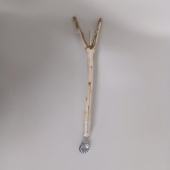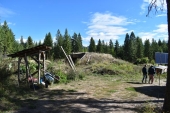I'd hoped to participate in the 2024 GAMCOD, but the timing didn't work to be able to prepare a bed this year to qualify. Based in part on our time as SEPPers at the end of September, we came away with some ideas as changes we would like to make to our property.
Unlike Wheaton Labs, we don't have an abundance of trees / wood. That said, every year we have some branches / trees come down and have some set aside over the years, so we can make something work. An alternative I've considered as well is that if we are short of wood to bury, I can do a short hugel, participate in the 2025 GAMCOD, then build higher as wood becomes available in the future.
I made the video yesterday, then worked with the scythe to clear an area and cleaned it up with the tractor, creating a pile of hay nearby (of course, I placed it where I'll want to access the pile of dirt with the tractor...sigh). I also moved some wood from a tree that came down in September nearby. I used my measuring wheel (metric) and measured off a plot to place the bed. The GAMCOD limit is 200 square feet, which converts to a bit over 18.5 square meters so I measured it out as 2 m by 9 m. The markers are tough to see in the image, but they are there.
This bed will be oriented east-west, so will ultimately have some different microclimates which should prove interesting. To start with, we will plant primarily annuals to get an immediate yield for the GAMCOD initiative. As time marches forward, I see more perennial and woody plants being involved. In the latter part of the build, I'd like to bury some raspberry canes (we have the type that bears on first year wood, so can be pruned down annually) - we've had some grow the following year from the prunings being in contact with the ground. We have some rhubarb to move to a better location, some horseradish that needs to be moved to an easier location to be able to harvest roots, black currants that need to be renewed which implies cuttings, and various odds and ends including sunchokes. I could also see asparagus going into the bed in the long term.
The location is chosen in part due to its proximity to the pile of dirt, but it will also help with dust abatement from the gravel road, noise from traffic, and perhaps some privacy elements.
Every winter we get snow, and in our windblown location, that implies drifting - every winter is different, but whenever we make changes like this, it does impact drift patterns, which also impacts spring melt and drainage. Our predominant winds are from the NW, with secondary direction from the SE. Since every winter is different from a snowfall perspective, it is tough to see what changes impact over time. I'd love to be able to plan and shift where some of the drifting occurs, but I may not live that long to be able to confirm impacts.
There are many other elements involved with this. I don't see building privacy berms like you see at base camp...they certainly serve their purpose but wouldn't be ideal in our context. Since we don't want to create frost pockets, I can't see digging down, which will make it unlikely that this hugel will qualify for a Badge Bit.


 10
10
















 6
6


















 6
6















 4
4





 1
1















 3
3















 1
1












